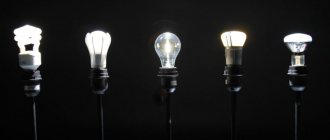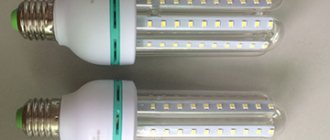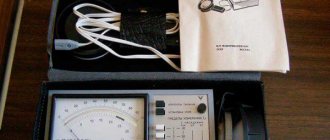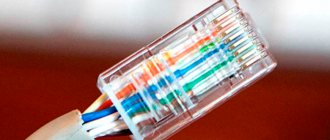The question of how luminous flux is measured began to matter to lighting users only when types of lamps appeared whose brightness was not equal to the power consumption measured in watts.
Let's figure out how the concept of brightness is related to the concept of illumination, as well as how you can imagine the distribution of light flux throughout the room and choose the right lighting device.
What is luminous flux?
Light flux is the power of light radiation visible to the human eye; light energy emitted by a surface (luminous or reflective). Luminous flux energy is measured in lumen-seconds and corresponds to 1 lumen emitted or perceived in 1 second. This indicator describes the total flow, without taking into account the concentrating efficiency of the entire device. This assessment also includes scattered, useless light, so the same number of lumens may appear in sources of different designs.
It is necessary to distinguish between the luminous value and the energy value - the latter characterizes light regardless of its property of causing visual sensations. Each photometric light quantity has an analogue that can be expressed quantitatively in units of energy or power. For light energy, this analogue is radiant energy, measured in joules.
Illumination concept
The luminous flux is measured under special laboratory conditions and cannot be determined spontaneously. Therefore, SNiP takes into account the amount of illumination, which, unlike the luminous flux, everyone can measure independently. It is a measure of the ratio of luminous flux, measured in lumens, to the surface area on which photons fall. The angle of incidence should be 90°. The unit of illumination is lux.
Surface illuminance unit
The dependence of a person’s psychological and physical states on light has long been established. If in low light the brain processes are depressed, then in bright light they are stimulated. But in any case, the retina and the body’s resources wear out. When designing lighting devices, a safety factor (SF) is determined, which should take into account the likely decline in illumination of the installation. For artificial light, the indicator provides for a decrease in brightness due to wear and tear of the optical components of the device and their natural contamination. The coefficient of natural illumination decreases due to changes in the reflective properties of surrounding objects.
Illumination measurements are carried out at workplaces along with determination of the level of pollution, sound vibrations, electromagnetic radiation, and in some industries, gamma radiation. The importance of knowing these parameters can hardly be overestimated when creating optimal working conditions, and all of them comply with sanitary rules and regulations. For example, the illumination should be:
- in the office - 300 lux;
- in the office for constant work with a computer - 500 lux;
- for technical and design bureaus - 750 lux.
If there is natural lighting in the room, the level of artificial background can be reduced.
Luminous flux unit
1 lumen is the light emitted by a source with a luminous intensity of 1 candela within a solid angle of 1 steradian. A 100-watt incandescent lamp produces approximately 1,000 lumens of light. The brighter the light source, the more lumens it emits.
In addition to lumens, there are other units of measurement that allow us to characterize light. It is possible to measure the spatial and surface flux density - this is how we know the luminous intensity and illumination. Luminous intensity is measured in candelas, illuminance in lux. But it is more important for the consumer to understand in what units the brightness of light bulbs and other lighting devices is indicated when selling. Some manufacturers report the number of lumens divided by watt. This is how luminous efficiency (luminous output) is measured: how much light a lamp produces using 1 watt.
Light measuring device
To check whether the illumination of the room meets the standards, a lux meter is used. The design of the meter includes a built-in or remote sensitive sensor with a converter, dial or digital indicator. The detector is placed on the surface in a horizontal position.
You may be interested in: Connecting a switch with an LED yourself
Note! Measurements are carried out according to GOST from 1996 and 2012. The device is used according to the instructions on the packaging product. Additionally, if you wish, you can view the available video tutorials.
In addition to the topic of what the device for measuring light is called, it is worth noting that there is also a lumenometer. Separately, artificial lighting with natural light is checked. When performing the verification procedure, shadows and other interference are excluded. It is important to note that in order to ensure that the results are not distorted, the measurement test is carried out after several hours of continuous operation of the lighting sources. It is advisable that the procedure be repeated.
Luxmeter
Defining formulas
Since any light source emits it unevenly, the number of lumens does not fully describe the lighting fixture. You can calculate the intensity of light in candelas by dividing its flux, expressed in lumens, by the solid angle, measured in steradians. Using this formula, it will be possible to take into account the totality of rays coming from the source when they intersect the surface of an imaginary sphere, forming a circle on it.
But the question arises what the number of candelas we find gives in practice; It is impossible to find a suitable LED or flashlight based only on the luminous intensity parameter; you also need to take into account the ratio of the scattering angle, which depends on the design of the device. When choosing lamps that shine evenly in all directions, it is important to understand whether they are suitable for the buyer's purposes.
If previously light bulbs for different rooms were selected based on the number of watts, then before purchasing LED lamps you will have to calculate their total brightness in lumens, and then divide this figure by the area of the room. This is how illumination is calculated, which is measured in lux: 1 lux is 1 lumen per 1 m². There are lighting standards for rooms for various purposes.
How is illumination related to luminous flux?
Illumination and luminous flux are different, although similar concepts.
Illumination is measured in lux rather than lumens. 1 lux means 1 lumen per 1 m2 of area. For clarity, you can compare force and pressure. Using a small needle and applying a minimum of force, a high specific pressure coefficient is created for a specific point. Similarly, a low beam of light can illuminate a separate area.
The interaction of light flux and illumination is easy to understand using the example of a table lamp with a luminous flux of 1000 lm. In order for the lighting to be complete, they are guided by SNiP 52.13330 standards. For the workplace, a value of 350 Lux is used, for manipulations with small parts - 500 Lux. Illumination is also affected by the distance of the light source, the color of foreign objects, and the presence of a mirror or window. That is, a table next to a white wall will receive more lux than a table next to a dark one.
To measure illumination, use a lux meter or a meter app on your smartphone.
Luminous flux measurement
Before releasing a product to the market, the manufacturer determines and measures the characteristics of the lighting device in the laboratory. It is impossible to do this at home, without special equipment. But you can check the numbers indicated by the manufacturer using the above formulas using a compact lux meter.
The difficulty in accurately measuring light is that it comes from all possible directions of propagation. Therefore, laboratories use spheres with an inner surface that has a high reflectivity - spherical photometers; They are also used to measure the dynamic range of cameras, i.e. photosensitivity of their matrices.
In everyday life, it makes more sense to measure such important light parameters as room illumination and pulsation coefficient. High pulsation ratio and dim lighting cause people to overstrain their eyes, which causes fatigue faster.
The light flux pulsation coefficient is an indicator characterizing the degree of its unevenness. Acceptable levels of these coefficients are regulated by SanPiN.
It is not always possible to notice with the naked eye that the light bulb is flickering. However, even a slight excess of the pulsation coefficient affects the human central nervous system negatively and also reduces performance. Light, which can pulsate unevenly, is emitted by all screens: computer and laptop monitors, tablet and mobile phone displays, and TV screens. Ripple is measured with a lux meter-pulse meter.
What is candela?
Another important characteristic of the light source is the candela, which is one of the 7 units of the International System of Units (SI) adopted by the General Conference on Weights and Measures. Initially, 1 candela was equal to the radiation of 1 candle, taken as the standard. This is where the name of this unit of measurement came from. Now it is determined using a special formula.
Candela is the intensity of light measured exclusively in a given direction. The propagation of rays over a part of the sphere outlined by a solid angle allows one to calculate a value equal to the ratio of the luminous flux to this angle. Unlike lumens, this value is used to determine the intensity of rays. This does not take into account useless, scattered light.
A flashlight and a ceiling light will have a different cone of light because the rays fall at different angles. Candelas (more precisely, millicandelas) are used to indicate the luminous intensity of sources with a directional glow: indicator LEDs, flashlights.
Lumens and Luxes
The amount of light flux is measured in lumens; this is a characteristic of its source. The number of rays that reach any surface (reflecting or absorbing) will already depend on the distance between the source and this surface.
The level of illumination is measured in lux (lx) with a special device - a lux meter. The simplest lux meter consists of a selenium photocell that converts light into electric current energy, and a dial microammeter that measures this current.
The spectral sensitivity of a selenium photocell differs from the sensitivity of the human eye, so correction factors have to be used in different conditions. The simplest lux meters are designed to measure one type of illumination, for example, daylight. Without using coefficients, the error can be more than 10%.
High-class lux meters are equipped with light filters, special spherical or cylindrical attachments (for measuring spatial illumination), devices for measuring brightness and checking the sensitivity of the device. Their error level is about 1%.
Poor indoor lighting contributes to the development of myopia, has a bad effect on performance, causes fatigue, and decreased mood.
The minimum illumination of the surface of a computer desk according to SanPiN is 400 lux. School desks must have an illumination level of at least 500 lux.
Color and spectral colors
What is color? Physics gives the following answer to this question: Color is a qualitative subjective characteristic of electromagnetic radiation in the optical range, determined on the basis of the emerging physiological visual sensation, and depending on a number of physical, physiological and psychological factors. [1.1]
Individual perception of color is determined by its spectral composition, as well as color and brightness contrast with surrounding light sources and non-luminous objects. [1.1]
In a continuous light spectrum, in which some colors smoothly transition into others so that it is difficult to determine exactly the boundaries of each color and its relationship with a certain wavelength, it is customary to distinguish the following colors depending on the wavelength [3.1]:
| No. | Color name | Wavelength(nm) | |
| From | Before | ||
| 1 | Violet | 380 | 440 |
| 2 | Blue | 440 | 480 |
| 3 | Blue | 480 | 510 |
| 4 | Green | 510 | 550 |
| 5 | Yellow-green | 550 | 575 |
| 6 | Yellow | 575 | 585 |
| 7 | Orange | 585 | 620 |
| 8 | Red | 620 | 780 |
The wave range from 0 nm to 380 nm is considered invisible and is called the ultraviolet region of optical radiation.
The wave range from 780 nm to 1 mm is considered invisible and is called the infrared region of optical radiation.
Continuous optical spectrum
Figure 1 shows the main maximum of the diffraction color spectrum.
The visual organs of living beings perceive light reflected from physical objects and objects. The color of an object perceived by the visual organs will correspond to the wavelengths reflected by these objects. For example, foliage appears green to us because the leaf reflects the green component of the spectrum, and, on the contrary, absorbs all other components. Or another example: an orange is orange, because it is the orange component of the light spectrum that is reflected by the orange.
The sensitivity of the visual organs of living beings is not constant in the zone of the visible light spectrum. For a person, for example, based on data from [3.2], the sensitivity of the visual organs is shown in Figure 2.
The spectral sensitivity of rod vision (Figure 2, curve 2 - the eye is adapted to night brightness) characterizes the operation of the eye with such a small amount of light that it is not enough to even partially excite the cones. The relative spectral sensitivity curve of the eye has a maximum at a wavelength of 507 nm.
For an eye adapted to daytime brightness V(λ) (Figure 2, curve 1), a twofold decrease in sensitivity is characteristic at wavelengths of 510 nm and 610 nm. If the eye is adapted to night brightness V'(λ) (Figure 2, curve 2), then a twofold decrease in sensitivity is observed at wavelengths of 455 nm. and 550 nm.
Figure 2. Relative spectral sensitivity of the human eye
The maxima on curves 1 and 2 in Figure 2, equal to unity, are relative. The fact is that the rod apparatus of human night vision is much more sensitive, and to perceive an extremely small light signal (for example, a barely visible point on a dark background), rods require approximately five hundred times less power than cones. In this case, the rods, which operate in peripheral (lateral) vision, do not allow one to determine the color of a point, while the cones, which fix a point in direct vision, make it possible to see its color [3.3].
In addition, the sensitivity of the human eye to different color components of light varies. Sensitivity is maximum at 555 nm (yellow-green light) and minimizes at longer (red light) and shorter (blue light) wavelengths. The sensitivity of the human eye to red radiation (650 nm) is only 10% of the maximum sensitivity. In other words, to achieve the same brightness sensation as yellow-green light, the intensity of red light must be ten times greater [4.1].
If we combine the visible red and blue ranges of the spectrum, we get a color wheel Figure 3. The color wheel is a way of representing the continuity of color transitions in the visible part of the spectrum. The sectors of the circle are painted in different color tones, placed in the order of spectral colors, with magenta connecting the extreme red and violet colors.
Figure 3. Color wheel and triads of colors that produce white when mixed.
The color wheel was first proposed by Isaac Newton in 1704. The color wheel is of great importance for understanding the laws of mixing spectral colors. So, for example, the vertices of a triangle inscribed in the color wheel clearly indicate triads of colors that, when mixed, will give white.
Figure 4. Visible spectrum color field.
In general, the color shades obtained by mixing simple spectral colors are presented in Figure 4.
Lumen and Watt
Energy-saving lamps with the same light output consume 5-6 times less electrical energy than incandescent lamps. LED – 10-12 times less. The power of the light flux no longer depends on the number of watts. But manufacturers always indicate watts, since the use of too powerful light bulbs in sockets not intended for such a load leads to damage to electrical appliances or a short circuit.
If you arrange the most common types of light bulbs in order of increasing light output, you can get the following list:
- Incandescent lamp – 10 lumens/watt.
- Halogen – 20 lumens/watt.
- Mercury – 60 lumens/watt.
- Energy saving – 65 lumens/watt.
- Compact fluorescent lamp - 80 lumens/watt.
- Metal halide - 90 lumens/watt.
- Light-emitting diode (LED) – 120 lumens/watt.
But most people are accustomed to looking at the number of watts specified by the manufacturer when purchasing light bulbs. To calculate how many watts per square meter you need, you first need to decide how bright the light in the room should be. 20 watts of incandescent lamp per 1 m² - this lighting is suitable for a workplace or living room; for a bedroom 10-12 watts per 1 m² will be enough. When purchasing energy-saving lamps, these numbers are divided by 5. It is also important to take into account the height of the ceiling: if it is higher than 3 m, the total number of watts should be multiplied by 1.5.











